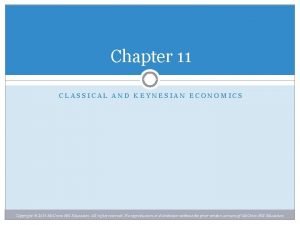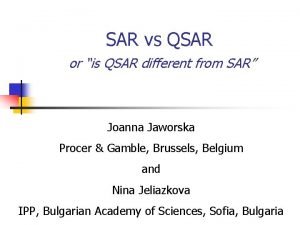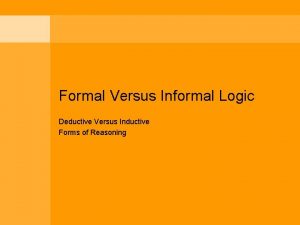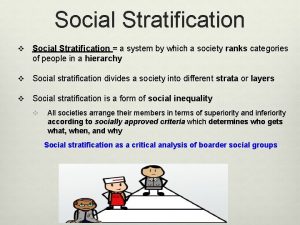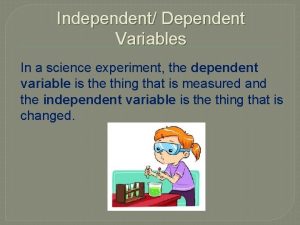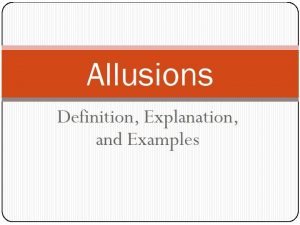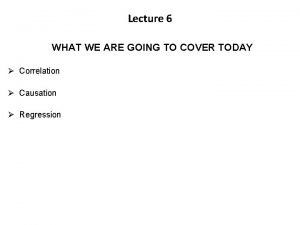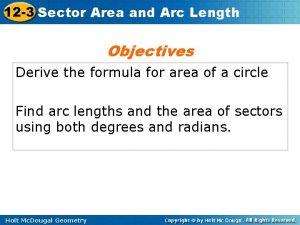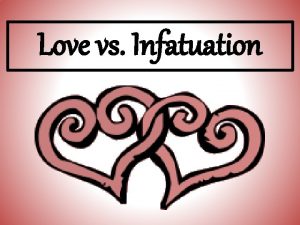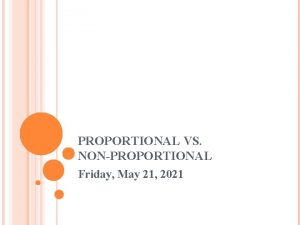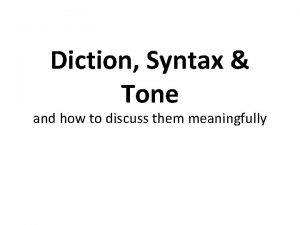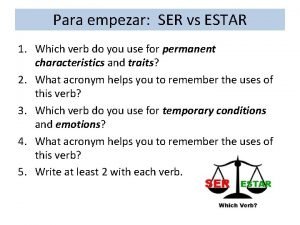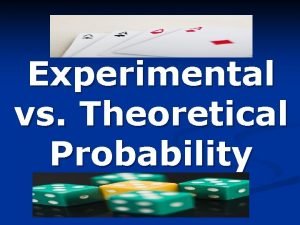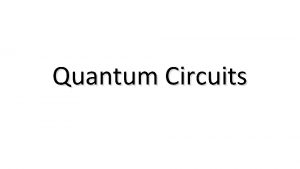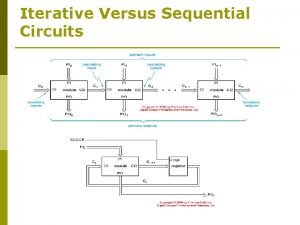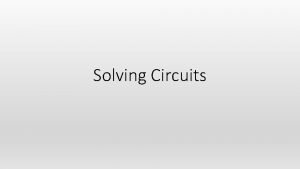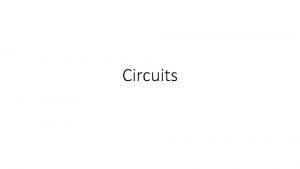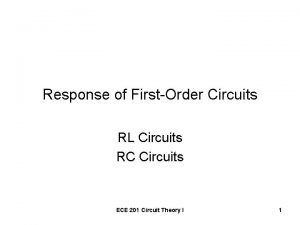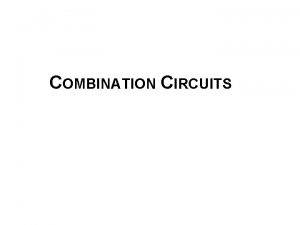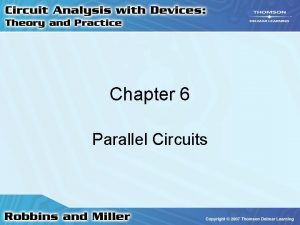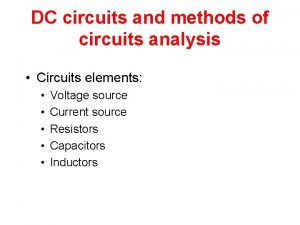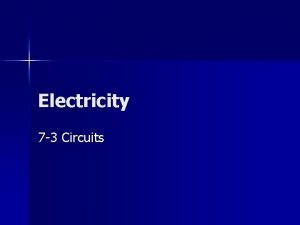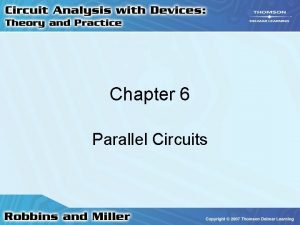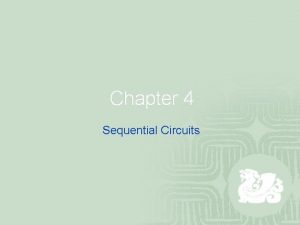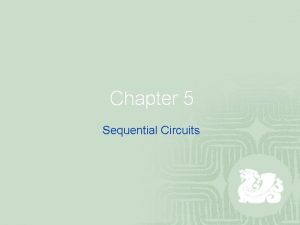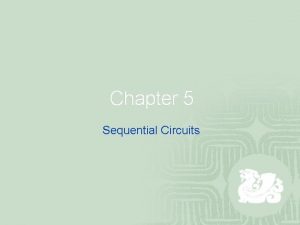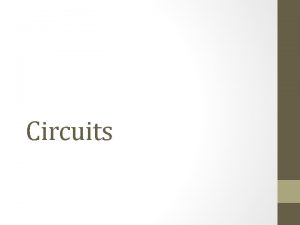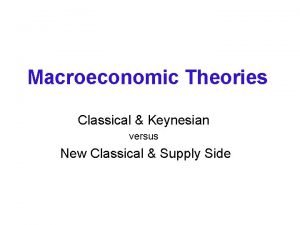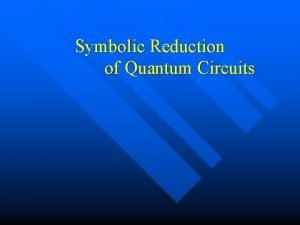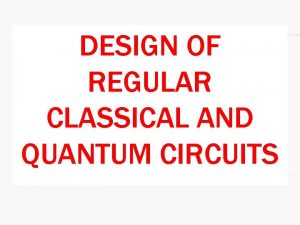Classical Versus Quantum Classical vs Quantum Circuits Goal










![Reversible Circuits • Reversible gate family [Toffoli 1980] (Toffoli gate) • Every Boolean function Reversible Circuits • Reversible gate family [Toffoli 1980] (Toffoli gate) • Every Boolean function](https://slidetodoc.com/presentation_image_h/1dabd013d54d3c363d99728cf8072a17/image-11.jpg)








![Polarizing Beam-Splitter CNOT gate from [Cerf, Adami, Kwiat] Polarizing Beam-Splitter CNOT gate from [Cerf, Adami, Kwiat]](https://slidetodoc.com/presentation_image_h/1dabd013d54d3c363d99728cf8072a17/image-20.jpg)






















- Slides: 42

Classical Versus Quantum

Classical vs. Quantum Circuits • Goal: Fast, low-cost implementation of useful algorithms using standard components (gates) and design techniques • Classical Logic Circuits – – – Circuit behavior is governed implicitly by classical physics Signal states are simple bit vectors, e. g. X = 01010111 Operations are defined by Boolean Algebra No restrictions exist on copying or measuring signals Small well-defined sets of universal gate types, e. g. {NAND}, {AND, OR, NOT}, {AND, NOT}, etc. – Well developed CAD methodologies exist – Circuits are easily implemented in fast, scalable and macroscopic technologies such as CMOS

Classical vs. Quantum Circuits • Quantum Logic Circuits – Circuit behavior is governed explicitly by quantum mechanics – Signal states are vectors interpreted as a superposition of binary “qubit” vectors with complex-number coefficients – Operations are defined by linear algebra over Hilbert Space and can be represented by unitary matrices with complex elements – Severe restrictions exist on copying and measuring signals – Many universal gate sets exist but the best types are not obvious – Circuits must use microscopic technologies that are slow, fragile, and not yet scalable, e. g. , NMR

Quantum Circuit Characteristics • Unitary Operations – Gates and circuits must be reversible (information-lossless) • Number of output signal lines = Number of input signal lines • The circuit function must be a bijection, implying that output vectors are a permutation of the input vectors – Classical logic behavior can be represented by permutation matrices – Non-classical logic behavior can be represented including state sign (phase) and entanglement

Quantum Circuit Characteristics • Quantum Measurement – Measurement yields only one state X of the superposed states – Measurement also makes X the new state and so interferes with computational processes – X is determined with some probability, implying uncertainty in the result – States cannot be copied (“cloned”), implying that signal fanout is not permitted – Environmental interference can cause a measurementlike state collapse (decoherence)

Classical vs. Quantum Circuits Classical adder cn– 1 a 0 s 0 b 0 s 1 a 1 b 1 s 2 a 2 b 2 s 3 a 3 Sum b 3 cn Carry

Classical vs. Quantum Circuits Quantum adder • Here we use Pauli rotations notation. • Controlled σx is the same as controlled NOT Controlled-controlled σx is the same as Toffoli Controlled σx is the same as Feynman

Reversible Circuits

Reversible Circuits • Reversibility was studied around 1980 motivated by power minimization considerations • Bennett, Toffoli et al. showed that any classical logic circuit C can be made reversible with modest overhead m outputs i … “Junk” … Reversible Boolean Circuit … “Junk” … f(i) n inputs Generic Boolean Circuit i …

Reversible Circuits • How to make a given f reversible – Suppose f : i f(i) has n inputs m outputs – Introduce n extra outputs and m extra inputs – Replace f by frev: i, j i, f(i) j where is XOR • Example 1: f(a, b) = AND(a, b) a b c Reversible AND gate a b f = ab c a b f 0 0 0 0 1 1 1 1 0 0 1 1 0 1 0 1 1 0 • This is the well-known Toffoli gate, which realizes AND when c = 0, and NAND when c = 1.
![Reversible Circuits Reversible gate family Toffoli 1980 Toffoli gate Every Boolean function Reversible Circuits • Reversible gate family [Toffoli 1980] (Toffoli gate) • Every Boolean function](https://slidetodoc.com/presentation_image_h/1dabd013d54d3c363d99728cf8072a17/image-11.jpg)
Reversible Circuits • Reversible gate family [Toffoli 1980] (Toffoli gate) • Every Boolean function has a reversible implementation using Toffoli gates. • There is no universal reversible gate with fewer than three inputs

Quantum Gates

Quantum Gates • One-Input gate: NOT – Input state: c 0|0 + c 1|1 NOT – Output state: c 1|0 + c 0|1 – Pure states are mapped thus: |0 |1 and |1 |0 – Gate operator (matrix) is – As expected: NOT

Quantum Gates • One-Input gate: “Square root of NOT” – Some matrix elements are imaginary – Gate operator (matrix): – We find: so |0 with probability |i/ 2|2 = 1/2 and |0 |1 with probability |1/ 2|2 = 1/2 Similarly, this gate randomizes input |1 – But concatenation of two gates eliminates the randomness!

Other variant of square root of not - we do not use complex numbers - only real numbers

Quantum Gates • One-Input gate: Hadamard H – Maps |0 1/ 2 |0 + 1/ 2 |1 and |1 1/ 2 |0 – 1/ 2 |1. – Ignoring the normalization factor 1/ 2, we can write |x (-1)x |x – |1 – x • One-Input gate: Phase shift

Quantum Gates Universal One-Input Gate Sets • Requirement: |0 U Any state |y • Hadamard and phase-shift gates form a universal gate set of 1 -qubit gates, every 1 -qubit gate can be built from them. • Example: The following circuit generates |y = cos |0 + ei sin |1 up to a global factor H 2 H

Other Quantum Gates

Quantum Gates • Two-Input Gate: Controlled NOT (CNOT) |x |y CNOT |x |x y |x |y |x y – CNOT maps |x |0 |x ||x and |x |1 |x ||NOT x – |x |0 |x ||x looks like cloning, but it’s not. These mappings are valid only for the pure states |0 and |1 – Serves as a “non-demolition” measurement gate
![Polarizing BeamSplitter CNOT gate from Cerf Adami Kwiat Polarizing Beam-Splitter CNOT gate from [Cerf, Adami, Kwiat]](https://slidetodoc.com/presentation_image_h/1dabd013d54d3c363d99728cf8072a17/image-20.jpg)
Polarizing Beam-Splitter CNOT gate from [Cerf, Adami, Kwiat]

Quantum Gates • 3 -Input gate: Controlled CNOT (C 2 NOT or Toffoli gate) |a |b |c |ab c

Quantum Gates • General controlled gates that control some 1 -qubit unitary operation U are useful etc. U U C(U) C 2(U)

Quantum Gates Universal Gate Sets • To implement any unitary operation on n qubits exactly requires an infinite number of gate types • The (infinite) set of all 2 -input gates is universal – Any n-qubit unitary operation can be implemented using (n 34 n) gates [Reck et al. 1994] • CNOT and the (infinite) set of all 1 -qubit gates is universal

Quantum Gates Discrete Universal Gate Sets • The error on implementing U by V is defined as • If U can be implemented by K gates, we can simulate U with a total error less than with a gate overhead that is polynomial in log(K/ ) • A discrete set of gate types G is universal, if we can approximate any U to within any > 0 using a sequence of gates from G

Quantum Gates Discrete Universal Gate Set • Example 1: Four-member “standard” gate set H CNOT Hadamard S Phase /8 (T) gate • Example 2: {CNOT, Hadamard, Phase, Toffoli}

Quantum Circuits

Quantum Circuits • A quantum (combinational) circuit is a sequence of quantum gates, linked by “wires” • The circuit has fixed “width” corresponding to the number of qubits being processed • Logic design (classical and quantum) attempts to find circuit structures for needed operations that are – Functionally correct – Independent of physical technology – Low-cost, e. g. , use the minimum number of qubits or gates • Quantum logic design is not well developed!

Quantum Circuits • Ad hoc designs known for many specific functions and gates • Example 1 illustrating a theorem by [Barenco et al. 1995]: Any C 2(U) gate can be built from CNOTs, C(V), and C(V†) gates, where V 2 = U 1/2 V V† V (1+i) (1 -i) (1+i) 1/2 (1 -i) (1+i) (1 -i)

Quantum Circuits Example 1: Simulation |0 |1 |x U ? = |0 |0 |0 |1 |1 |1 |x V V † |x V |x

Quantum Circuits Example 1: Simulation (contd. ) |1 |1 |x U ? = |1 |1 |0 |1 |x V V † V|x • Exercise: Simulate the two remaining cases V U|x

Quantum Circuits Example 1: Algebraic analysis x 1 ? = x 2 x 3 U V U 0 U 1 V† U 2 U 3 V U 4 U 5 • Is U 0(x 1, x 2, x 3) = U 5 U 4 U 3 U 2 U 1(x 1, x 2, x 3) = (x 1, x 2, x 1 x 2 U (x 3) ) ? We will verify unitary matrix of Toffoli gate Observe that the order of matrices Ui is inverted.

Quantum Circuits Example 1 (contd); Unitary matrix of a wire Kronecker since this is a parallel connection We calculate the Unitary Matrix U 1 of the first block from left. Unitary matrix of a controlled V gate (from definition)

Quantum Circuits Example 1 (contd); Unitary matrix of CNOT or Feynman gate with EXOR down We calculate the Unitary Matrix U 2 of the second block from left. As we can check in the schematics, the Unitary Matrices U 2 and U 4 are the same

Quantum Circuits Example 1 (contd);

Quantum Circuits Example 1 (contd); – U 5 is the same as U 1 but has x 1 and x 2 permuted (tricky!) – It remains to evaluate the product of five 8 x 8 matrices U 5 U 4 U 3 U 2 U 1 using the fact that VV† = I and VV = U

Quantum Circuits Example 1 (contd); – We calculate matrix U 3 1 0 1 0 0 0 0 v 00 v 10 0 0 v 01 v 11 = This is a hermitian matrix, so we transpose and next calculate complex conjugates, we denote complex conjugates by bold symbols

Quantum Circuits Example 1 (contd); – U 5 is the same as U 1 but has x 1 and x 2 permuted because in U 1 black dot is in variable x 2 and in U 5 black dot is in variable x 1 – This can be also checked by definition, see next slide. U 5 =

Quantum Circuits Example 1 (here we explain in detail how to calculate U 5) x 1 x 2 x 3 . x 1 x 2 V U 5 U 6 is calculated as a Kronecker product of U 7 and I 1 U 7 is a unitary matrix of a swap gate x 3 U 6 . V U 1 U 6 U 5 = U 6 U 1 U 6

Quantum Circuits Example 1 (contd); – It remains to evaluate the product of five 8 x 8 matrices U 5 U 4 U 3 U 2 U 1 using the fact that VV† = I and VV = U U 1

Quantum Circuits • Implementing a Half Adder – Problem: Implement the classical functions sum = x 1 x 0 and carry = x 1 x 0 • Generic design: |x 1 |x 0 |y 1 |y 0 Uadd |x 1 |x 0 |y 1 carry |y 0 sum

Quantum Circuits • Half Adder: Generic design (contd. )

Quantum Circuits • Half Adder: Specific (reduced) design |x 1 |x 0 |y C 2 NOT (Toffoli) CNOT |x 1 sum |y carry
 What is a parallel circuit in physics
What is a parallel circuit in physics What is the goal of a red versus blue team exercise?
What is the goal of a red versus blue team exercise? Neoclassical economics
Neoclassical economics Classical versus keynesian economics
Classical versus keynesian economics Quantum physics vs mechanics
Quantum physics vs mechanics Quantum physics vs quantum mechanics
Quantum physics vs quantum mechanics Sar vs qsar
Sar vs qsar Opinion versus fact
Opinion versus fact Real assets versus financial assets
Real assets versus financial assets Informal deduction
Informal deduction Mood of poetry
Mood of poetry Muscular-anal stage
Muscular-anal stage Risk versus uncertainty
Risk versus uncertainty Effective interest rate
Effective interest rate Religion and conflict theory
Religion and conflict theory Graft-versus-host hastalığı
Graft-versus-host hastalığı Revolusi gereja
Revolusi gereja Independent v dependent variable
Independent v dependent variable Allusion versus illusion
Allusion versus illusion The six types of conflict
The six types of conflict Peta konsep aceh versus portugis dan voc
Peta konsep aceh versus portugis dan voc Karapatang panlipunan at pangkabuhayan
Karapatang panlipunan at pangkabuhayan Statistical versus deterministic relationship
Statistical versus deterministic relationship Direct versus indirect speech
Direct versus indirect speech Arc length versus sector area
Arc length versus sector area Infatuation v love
Infatuation v love God's plan vs man's plan
God's plan vs man's plan Direct financing
Direct financing Central vs main idea
Central vs main idea Nature versus nurture debate
Nature versus nurture debate Communism is better than capitalism pros and cons
Communism is better than capitalism pros and cons Nominal vs real return
Nominal vs real return Drama and short story differences
Drama and short story differences Proportional vs non proportional relationship
Proportional vs non proportional relationship Diction/syntax
Diction/syntax Past perfect simple y past perfect continuous
Past perfect simple y past perfect continuous Visie versus missie
Visie versus missie Hurricane vs tornado
Hurricane vs tornado What was the impact of plessy versus ferguson
What was the impact of plessy versus ferguson Ser vs estar acronym
Ser vs estar acronym Uses of preterite
Uses of preterite Theoretical probability
Theoretical probability What is a pshycopath
What is a pshycopath



